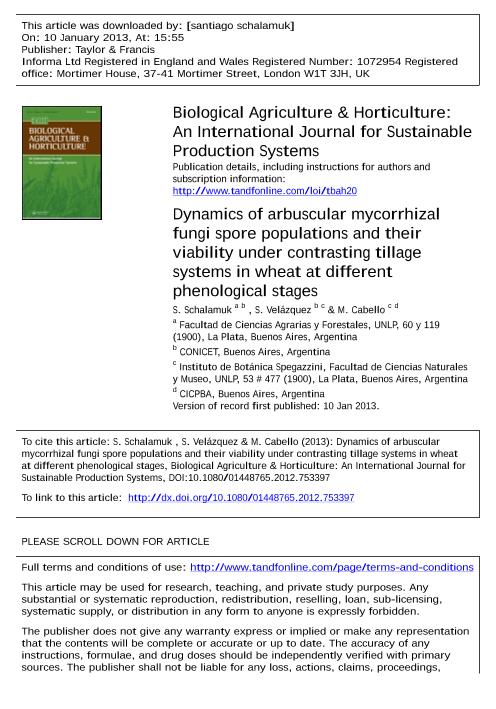Mostrar el registro sencillo del ítem
dc.contributor.author
Schalamuk, Santiago

dc.contributor.author
Velázquez, María Silvana

dc.contributor.author
Cabello, Marta Noemí

dc.date.available
2017-08-09T14:33:04Z
dc.date.issued
2013-01
dc.identifier.citation
Schalamuk, Santiago; Velázquez, María Silvana; Cabello, Marta Noemí; Dynamics of arbuscular mycorrhizal fungi spore populations and their viability under contrasting tillage systems in wheat at different phenological stages; A B Academic Publisher; Biological Agriculture & Horticulture; 29; 1; 1-2013; 38-45
dc.identifier.issn
0144-8765
dc.identifier.uri
http://hdl.handle.net/11336/22101
dc.description.abstract
Arbuscular mycorrhizal fungi (AMF) are influenced by soil management. The use of different tillage systems affects AMF activity. AMF spores are formed in soils or roots and provide a long-term reservoir of inoculum in the field. As spores can persist in soils, they reflect the accumulated sporulation history of the respective soil and not necessarily the current symbiosis of the crop. The aim of this study was to evaluate the AMF spore population dynamics and spore viability in conventional tilled and non-tilled soils throughout the wheat growing cycle and its fallow in the warm temperate Argentine Pampas. It was found that the differences in spore abundance between both tillage systems depend on the phenological stage of the crop. In both years, at the early phenological stages of the wheat crop, spore counts were about two or three times higher in no-tillage (NT) than in conventional tillage (CT). The lower spore counts in CT at the end of the fallow and at the early crop stages could be explained by the dilution of the AMF propagules in the zone of seedling establishment by ploughing. The percentages of viable spores varied with the treatments and the sampling periods, with values ranging from 10.5% to 58.8%, and were higher in CT in all the phenological stages and significantly higher at tillering stage. Assuming that a viable spore could be newly formed, then the lower percentages of viable spores in NT may suggest a higher accumulation of old residual spores.
dc.format
application/pdf
dc.language.iso
eng
dc.publisher
A B Academic Publisher

dc.rights
info:eu-repo/semantics/openAccess
dc.rights.uri
https://creativecommons.org/licenses/by-nc-sa/2.5/ar/
dc.subject
Conventional Tillage
dc.subject
Glomeromycota
dc.subject
No-Tillage
dc.subject
Number of Spores
dc.subject
Vital Stain
dc.subject.classification
Bioquímica y Biología Molecular

dc.subject.classification
Ciencias Biológicas

dc.subject.classification
CIENCIAS NATURALES Y EXACTAS

dc.title
Dynamics of arbuscular mycorrhizal fungi spore populations and their viability under contrasting tillage systems in wheat at different phenological stages
dc.type
info:eu-repo/semantics/article
dc.type
info:ar-repo/semantics/artículo
dc.type
info:eu-repo/semantics/publishedVersion
dc.date.updated
2017-08-04T14:00:43Z
dc.journal.volume
29
dc.journal.number
1
dc.journal.pagination
38-45
dc.journal.pais
Reino Unido

dc.journal.ciudad
Berkhamsted
dc.description.fil
Fil: Schalamuk, Santiago. Consejo Nacional de Investigaciones Científicas y Técnicas. Centro Científico Tecnológico Conicet - La Plata; Argentina. Universidad Nacional de La Plata. Facultad de Ciencias Agrarias y Forestales; Argentina
dc.description.fil
Fil: Velázquez, María Silvana. Consejo Nacional de Investigaciones Científicas y Técnicas. Centro Científico Tecnológico Conicet - La Plata; Argentina. Universidad Nacional de la Plata. Facultad de Ciencias Naturales y Museo. Instituto de Botánica Spegazzini; Argentina
dc.description.fil
Fil: Cabello, Marta Noemí. Universidad Nacional de la Plata. Facultad de Ciencias Naturales y Museo. Instituto de Botánica Spegazzini; Argentina. Provincia de Buenos Aires. Gobernación. Comisión de Investigaciones Científicas; Argentina
dc.journal.title
Biological Agriculture & Horticulture

dc.relation.alternativeid
info:eu-repo/semantics/altIdentifier/doi/http://dx.doi.org/10.1080/01448765.2012.753397
dc.relation.alternativeid
info:eu-repo/semantics/altIdentifier/url/http://www.tandfonline.com/doi/abs/10.1080/01448765.2012.753397
Archivos asociados
